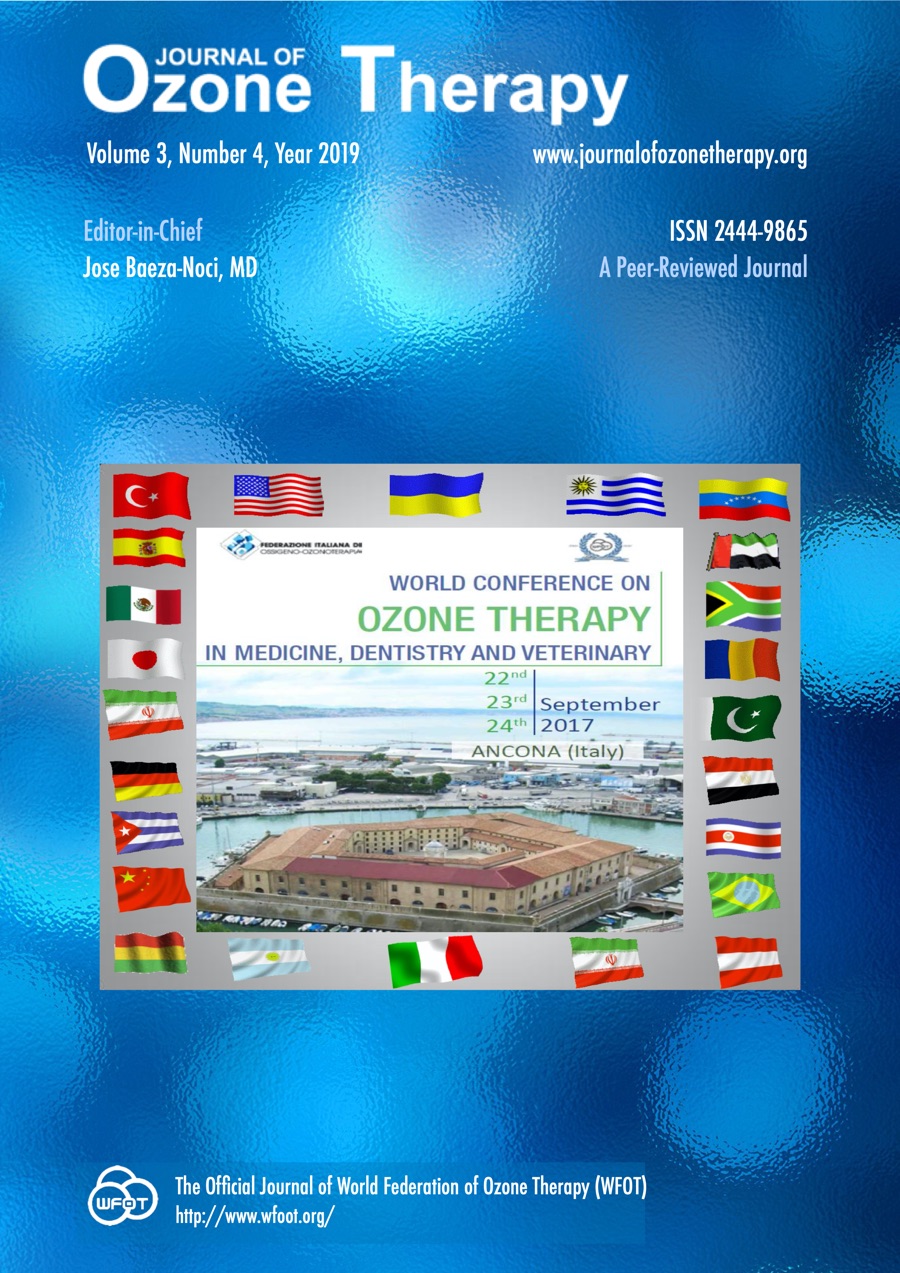Oxygen ozone therapy in interventional rehabilitative medicine [abstract]
DOI:
https://doi.org/10.7203/jo3t.3.4.2019.15535Keywords:
low back pain, radiculopathy, ozone therapy Abstract
Abstract
PURPOSE: The Interventional Physical and Rehabilitation Medicine (IPRM) is the possibility by physiatrist to insert in the individual rehabilitation project, with the most appropriate timing, an interventional procedure to support the conservative applied methods.
As other techniques of interventional physical medicine that use needle, oxygen-ozonotherapy may also benefit from the effect generated by this reflux release route of anti-algae kinines. The needle-induced micro lesion stimulates the body's production of substances such as histamine and serotonin. This stimulation has a specific action, improving local microcirculation and causing a greater oxygenation of the tissues.
Starting from this assumption, we wanted to test the effectiveness of this approach in treating low back pain.
DESIGN: This pilot study carried out at University Center of Physical and Rehabilitative Medicine of “G.d’Annunzio” University in accordance with the Helsinki Declaration of 1964. All participants were informed about the study methods and issued their written consent before making the therapeutic protocol.
MATERIAL and METHODS: Inclusion criteria were: 18 years of age, with chronic lumbar radiculopathy, pain for more than one month, pain level of at least 3 on Visual Analogue Scale (VAS scale), written informed consent.
In the 45 patients with lumbar radiculopathy, at magnetic resonance imaging (MRI) was demonstrated the presence of 5 herniated disc, 19 multiple slipped disc, 21 localized protrusions.
Patients are evaluated at T0, T1 (after 24 hours from the first session), T2 (end cycle) and one-month follow-up after the end of the treatment, with Visual Analogue Scale and Oswestry Disability Index.
The therapeutic protocol includes 3 cycles of oxygen-ozone therapy at 40 mcrg/mL, with a cycle every 15 days.
RESULTS: The results are only preliminary, because not all patients have completed the therapeutic cycle, so we do not have all the data to complete the statistical analysis.
The data obtained at this time show a significant reduction of VAS and improvement of Oswestry Disability Index.
DISCUSSION: Surely from a clinic point of view, there have been improvements in the reduction of pain, motility and quality of life of the patient. These obvious aspects of the clinical eye must be supported by
statistical analysis. The data about the pain trend reduction are very impressive expecially after 24 hours from the first session of treatment.
CONCLUSION: The outcome of these patients, evaluated clinically and with appropriate assessment scales, demonstrated mini-invasiveness and tolerability of this type of treatment of Interventional Physical and Rehabilitation Medicine. In according to the clinical analysis, it seems that the oxygen-ozone therapy is confirming its efficacy in the treatment of chronic lumbar radiculopathy with pain for more than one month.
 Downloads
Downloads
 References
References
Bellomo RG, Carmignano SM, Palermo T, Cosenza L, Saggini A, Saggini R. Integrated approach to physical medicine and rehabilitation. In: Nonsteroidal Anti-Inflammatory Drugs. Croatia; 2017. ISBN: 978-953-51-3444-2.
Bocci V, Di Paolo N. Oxygen-ozone therapy in medicine: an update. Blood Purif. 2009;28(4):373-6. doi: 10.1159/000236365.
ISCO3 Ozone Therapy and its Scientific foundation. ISCO3, Madrid, 2012.
Viebahn-Hänsler R. Ozon-Sauerstoff-Therapie Ein praktisches Handbuch. Haug/Thieme. Stuttgart. 2009.
Melzack R, Wall PD. Pain mechanisms: a new theory. Science. 1965;150(3699):971-979.
Australian Association of Muscoloskeletal Medicine. A syllabus of Muscoloskeletal Medicine. Fifth edition. Sidney:AAMM; 2001.
Downloads
Published
How to Cite
-
Abstract448
-
PDF265
Issue
Section
License
Journal of Ozone Therapy applies the Creative Commons Attribution-NonCommercial 4.0 International License (CC BY NC 4.0) license to works we publish.
Under this license, authors retain ownership of the copyright for their content, but allow anyone to download, reuse, reprint, modify, distribute and/or copy the content as long as the original authors and source are cited. No permission is required from the authors or the publishers.
You may not use the material for commercial purposes.
Appropriate attribution can be provided by simply citing the original article, provide a link to the license, and indicate if changes were made.
You may do so in any reasonable manner, but not in any way that suggests the licensor endorses you or your use.




